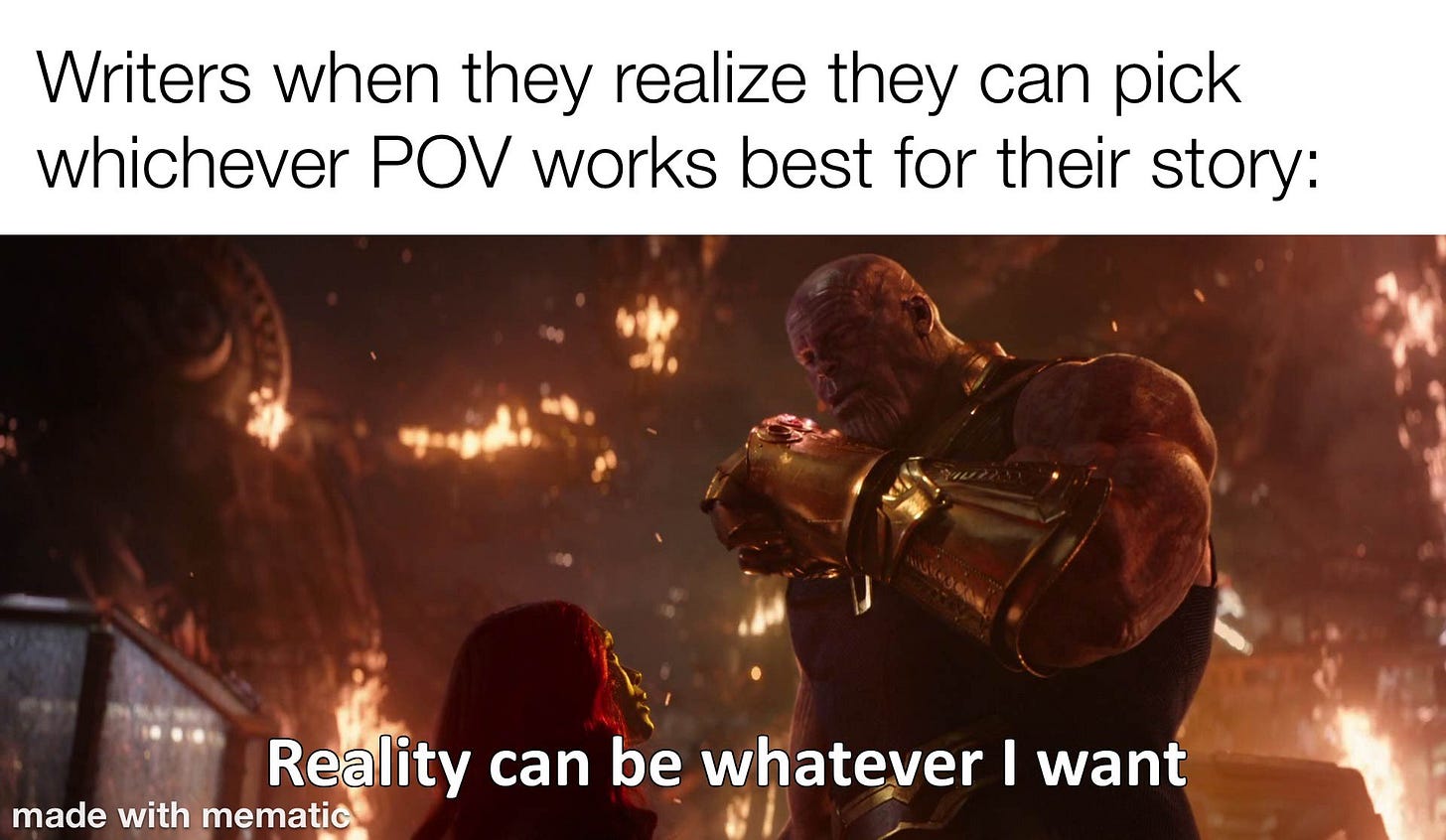How to Choose the Right POV For Your Story
First, Second, Third, fourth (yes, seriously). What does it all mean?
So, you just got a new story idea. Congratulations! Have you decided which point of view (POV) you’ll use? Oh, you haven’t? Well, it’s a good thing you’re here. In fact, that’s a crazy coincidence. Did you really just click on this right as inspiration struck? Oh, you were just playing along to be nice. Okay, that makes more sense.
Well, in any case, deciding on a POV (or multiple POVs) is a decision every writer faces when they decide to write something. It doesn’t matter if it's a short story, a novel, a microfiction, or even a poem!
How you tell the story is nearly as important as the story itself. So, join me as we explore all the variations of POV in writing and how I approach stories from multiple perspectives.
The Four (Yes, Seriously) Main Types of POVs in Storytelling
When I sat down to consider how I would approach this topic, I realized I was thinking from a first-person point of view.
Then I started thinking about what it would be like if I thought of myself in the third person all the time, and my head started to hurt, so I wouldn’t recommend that.
Jokes aside, I figured the best place to start was a rundown of all the options at your disposal. So, here are the four (yes, four) main types of POVs:
First Person
In this type of story, one person is narrating at a time. You can have stories in first person with multiple POVs, but for now, let’s assume there’s just one narrator for the whole piece. If you’re writing in the first person, then you're writing from inside their head.
When referring to them, we say “I.” So, an example would be, “I decided to write this example.” The main benefit of this approach is that you can really get inside the character’s head and tailor the voice of the narration to make it feel like it’s them talking to the reader.
Second Person
Second-person writing uses the “you” pronoun. So, an example would be something like, “You decided to write this example.” It’s not super common, but if you’re like me and you read Choose Your Own Adventure books as a kid, a lot of these were written in the second person.
In fact, the first branching narrative story I ever wrote was written in 2nd person. This POV is helpful if you’re trying to pull the reader into the story and make them think it’s them experiencing it, as opposed to a character that you created.
Third Person
This one comes with some caveats that we’ll cover in a separate section, but suffice to say, 3rd person stories use pronouns like “he, she, and they” to narrate the story. Think of this POV as if you’re the camera person in a TV show or movie.
You're describing what’s happening from a disconnected perspective (the level of which changes between limited and omniscient, but again, I’ll explain that momentarily). So, an example of how this looks would be something like “He decided to write an example,” or “Bradley decided to write an example,” which also works as a third-person statement. The benefit of this approach is that you can move around more easily in your narration since you’re not tied to one specific person.
Fourth Person
I know you’re shaking your head, but hear me out on this one. There’s some debate about whether this is a real option, but when I read the definition of a fourth-person POV, I understood where they were coming from, so I decided to include it here. It basically means that you’re telling the story from the POV of a collective group.
Therefore, you would use “we, us, our” terms to describe things. It’s a collective voice of sorts. Now, I’m not sure when you would use something like this, but my horror brain immediately thought a hive-mind type of story from the perspective of the collective would be cool. Feel free to use that idea if you’re going to try this one out!
Don’t Forget to Choose a Tense!
Another important factor is deciding which tense to write in. Now, the vast majority of stories and books are written in past tense (example: “Bradley added this later because he forgot to mention this in the first draft of the article”), but some stories use present tense as well.
Remember that present tense means things are happening in real time (example: “you stop to consider this as an option”). Technically, you could do future tense as well where you’re talking about things that will happen, but I’ve never personally seen this done before. You could absolutely try, though, if you wanted!
Huge shout out to
for their comment about this aspect of choosing your POV! I totally forgot to include this in the first draft of this article, but it’s an important factor to consider!What About Third Person Limited and Third Person Omniscient?
And here’s where I have to write an entire section about the two types of third-person writing because this one just HAD to be different. I swear, the others were all fine with having just one version. Even the fourth-person POV was sort of normal!
It can be a little confusing, but once you see the difference between third-person limited and third-person omniscient, you’ll sort of understand why it needs to be more complicated than the other POVs. It’s still annoying, though.
In Third Person Omniscient storytelling, the narrator knows everything about the story and characters. When you’re narrating, you can jump in and out of anyone’s mind that you like.
You can jump forward and backward in time as well. If you're so inclined, you can even confidently declare how characters feel about certain things. This option basically turns on “God Mode” for the narrator. Nothing is off-limits.
In contrast, a Third Person Limited POV is when the author sticks closely to one character but still keeps the narration in the third person. Think of this option as more “zoomed in,” where you only know as much as that character knows.
This option is a nice blend of first and third person because you can still get to know the character and adapt the narration to their personality, but you’re not required to be inside their head.
Okay, with all that out of the way, let’s talk about how to decide which POV is best for your story!
5 Ways to Decide on a POV for Your Story
Now that we’ve established all your options, the next logical question is, “How do I pick?” Some writers will tell you that they just prefer writing in one POV regardless of the story, and that’s totally fine.
If you’re most comfortable with 1st person, then you can rock that. If you’d rather be in the third person all the time, that’s cool, too!
Some people will tell you that certain POVs, like 3rd person, are easier to sell or pitch to literary agents, and while there may be some truth to that, my philosophy has always been that you should write in whichever POV is best for the story.
So, here’s five ways to decide:
Write a Few Versions of the Same Scene: You could start by choosing a scene (or it could be the beginning of the story, too, if you prefer) and try writing a few paragraphs in different POVs. Think of it like the writer’s version of test-driving the story before you decide to close the deal and commit to a specific POV.
Consider the Goal of the Story: Is the story about one person’s journey, or is it about a group of people? Will the internal thoughts of any one character play a major role? Asking yourself questions like these will help you figure out the scope of the tale, ultimately making it clear which POV is the best vessel for your story to inhabit.
Trust Your Instincts: Think back to when you first got the idea for the story. When you imagined the scenes playing out in your head (because I know you did. All writers do this), what did that look like? Was it zoomed in on one person, or were you jumping between perspectives? Trust your writer's instincts. If the idea came to you in 1st person, then use that. Don’t overcomplicate it.
Ask Your Audience: Your readers may have a preference for POVs that they like to read! Try posting a poll or writing a note here on Substack and ask people to weigh in with their favorite POVs they like reading or writing. Once you have a consensus among your followers and subscribers, you’ll know what’s going to work best for them.
When it Doubt, Read it Out (Loud): Reading your work out loud offers a fast track to figuring out a lot of things about your story. It can help you catch typos, awkward dialogue, and all manner of other things. It could also help you decide on the right POV. If the story doesn’t “sound” right in the first person, you’ll hear it. The flow may be off, or the big moments may not hit right. So, keep an ear out!
And that’s it! Between those five steps, you should be able to discover which POV is the best fit for your story. If you have other ways of deciding, I’d love to hear them! Let me know in the comments.
Bradley’s Bite-sized Guide to Writing Multiple POVs
Before we wrap this one up, I must also touch upon multiple POVs in a story. This could easily be its own article (and if you’d like one, let me know in the comments), but it’s something to consider if you’re doing a large-scale story.
Now, when I say this, I’m not talking about changing from first person to third person (though I have done that before in my STALEMATE series). In this case, I’m talking about switching from one character to another (or several others) as part of the storytelling focus.
A common example is a story written in the first person, where chapters switch between multiple characters' perspectives. I approach multiple POVs primarily this way, but you can also do the same with third-person limited stories, for example.
My current project that I’m writing for the #SpriNoWriMa challenge that’s currently underway has six POVs over the course of the book. You can learn about each of them here if you’re curious, but if that sounds like a lot of POVs, that’s because it is!
Why are there so many, I hear you ask? Well, in the case of that story, I’m writing in first person, but I’m also trying to showcase something happening on a global scale. For me, the best way to do that was to jump between several characters in different locations and walks of life. That way, readers can see what’s happening from a number of different angles.
If you’re trying to accomplish a similar scope or want to tell a story across multiple time periods, this is a great way to keep things focused and character-driven while also giving yourself the freedom to show different perspectives.
Here’s a few things to consider if you’re going to have multiple POVs:
Make sure you stay organized. If you’re a serial pantser like me, you may want to consider becoming a plantser that does outlines on the side. When you have multiple POVs moving in parallel, you’ll be more vulnerable to plot holes and inconsistencies, so I highly recommend mapping things out ahead of time.
When deciding on how many POVs to have, ask yourself if each perspective adds something significant to the story. If the story would be the same without them, then they’re not worth the extra word count. Only add new POVs if they bring something significant to the tale you’re trying to tell.
Make each POV feel distinct. I like writing multiple POVs in first person because I can tailor the narration to sound like each character’s personality. That way, when you’re reading one of their chapters, it feels slightly different in voice and tone to a different character’s chapter.
Don’t feel like your story has to have multiple POVs all the way through. You can give your characters plot armor if you want, but imagine how shocking it would be to have your book start with multiple POVs only to end with a few or even one left. Don’t be afraid to experiment!
Those are the main tips that come to mind, but If you’d like me to dive deeper into writing stories with multiple POVs, let me know in the comments!
POV: You Just Decided on a POV
I just checked the word count for this article, and it’s over two thousand words. I told myself this would be a short one! In any case, if you made it all the way to the end, first of all, thank you. Second, I hope this piece helped you better understand all the options you have for telling your stories.
Do you have a preferred POV? What other topics would you like me to cover about the craft of writing? Let me know in the comments, or tag me in a note so I can hear your thoughts! In the meantime, have a great rest of your week!







I really appreciate this break down! It was easy to digest and I felt like I was able to retain a lot of solid information! 💪
I’ve been attempting 3rd person limited recently, as opposed to 3rd omniscient. It’s a challenge for me, but has been recommended to me as a way to make stories more immediate, less general. I read your article with great interest, as I am a new writer and had not thought about what I was doing in relation to person.